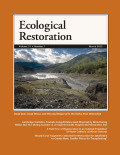
Ecological Restoration
Scope & Guideline
Cultivating knowledge for a greener tomorrow.
Introduction
Aims and Scopes
- Ecosystem Restoration Techniques:
The journal emphasizes various methodologies for restoring ecosystems, including but not limited to plant community recovery, soil amendments, and management of invasive species. - Biodiversity Assessment and Monitoring:
A core focus is on assessing biodiversity in restored areas, evaluating species composition, and understanding ecological interactions to inform future restoration practices. - Socio-Ecological Dynamics:
The intersection of social sciences with ecological restoration is highlighted, exploring community engagement, public perception, and socio-political factors influencing restoration projects. - Long-Term Ecological Monitoring:
Research that investigates the long-term outcomes and sustainability of restoration efforts is a key area, providing insights into the effectiveness and adaptability of various approaches over time. - Climate Change Mitigation and Adaptation:
The journal addresses the role of ecological restoration in climate change mitigation, discussing strategies that enhance resilience of ecosystems against climate-related challenges.
Trending and Emerging
- Community Engagement and Social Equity:
There is a growing emphasis on the role of community involvement and social equity in restoration projects, with studies exploring how diverse stakeholders can influence restoration outcomes and decision-making processes. - Interdisciplinary Approaches:
An increasing number of papers are integrating methods and insights from various disciplines, including social sciences, economics, and environmental design, to address complex restoration challenges. - Restoration in Urban Environments:
Urban ecological restoration is gaining traction, with a focus on enhancing biodiversity and ecosystem services in highly urbanized areas, indicating a shift towards addressing ecological needs in human-dominated landscapes. - Climate Resilience and Adaptive Restoration:
Research is increasingly highlighting strategies for enhancing the resilience of ecosystems to climate change, focusing on adaptive management techniques that allow for flexibility in restoration practices. - Technological Innovations in Restoration:
The application of new technologies, such as remote sensing and data analytics, in monitoring and assessing restoration outcomes is emerging as a significant theme, reflecting the importance of data-driven approaches in ecological restoration.
Declining or Waning
- Traditional Restoration Practices:
There has been a noticeable decline in papers focusing solely on traditional restoration practices without integrating innovative or adaptive approaches, suggesting a shift towards more dynamic and context-specific methodologies. - Species-Specific Studies Without Broader Context:
Research concentrating on single species restoration efforts, without addressing broader ecosystem interactions or community impacts, appears to be less prominent, reflecting a growing recognition of the need for holistic approaches. - Generalized Invasive Species Management:
Studies that provide generalized management strategies for invasive species without localized or context-specific adaptations are becoming less frequent, indicating a trend towards more tailored solutions based on ecological and social contexts.
Similar Journals
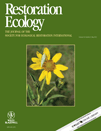
RESTORATION ECOLOGY
Empowering Restoration through Innovative ResearchRESTORATION ECOLOGY is a leading international journal dedicated to the science and practice of ecological restoration, published by WILEY. With an ISSN of 1061-2971 and a robust E-ISSN of 1526-100X, this journal has successfully positioned itself within the top quartiles (Q1) in significant categories such as Ecology, Evolution, Behavior and Systematics, and Nature and Landscape Conservation, showcasing its high-impact contributions to these vital fields. RESTORATION ECOLOGY has been actively disseminating critical research since 1993 and continues to thrive as it converges toward 2024. Ranked impressively within Scopus, it stands at #98 out of 721 in Agricultural and Biological Sciences and #30 out of 211 in Environmental Science, emphasizing its substantial influence and reach. While the journal operates under traditional access guidelines, it serves as an invaluable resource for researchers, professionals, and students alike, aiming to advance knowledge and practical solutions for biodiversity conservation and ecosystem rehabilitation globally. For those interested in the intersection of ecological theory and practical restoration applications, RESTORATION ECOLOGY is a key outlet for fostering dialogue and collaboration.
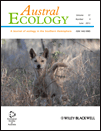
AUSTRAL ECOLOGY
Championing impactful research in ecology and evolution.AUSTRAL ECOLOGY, published by WILEY, is a key journal in the field of ecology, with a focus on ecological research from the Southern Hemisphere and beyond. With an ISSN of 1442-9985 and an E-ISSN of 1442-9993, this journal serves as a vital platform for the dissemination of significant findings related to ecology, evolution, behavior, and systematics. Currently holding a commendable Q2 ranking in both Ecology and Ecology, Evolution, Behavior and Systematics categories as of 2023, AUSTRAL ECOLOGY is recognized for its rigorous peer-review process and impactful research contributions, as evident from its Scopus rankings in the 56th percentile for both Agricultural & Biological Sciences and Environmental Science. Researchers, professionals, and students engaged in ecological studies can benefit from the journal's open access options, enabling wider accessibility to critical ecological insights and advancements in the field. Established in 1981, with an evolving legacy through its converged years from 1996 to 2024, AUSTRAL ECOLOGY remains committed to advancing ecological knowledge and fostering a deeper understanding of ecological dynamics in our ever-changing environment.

BIOLOGICAL INVASIONS
Fostering insights for a sustainable ecological future.BIOLOGICAL INVASIONS, published by Springer, stands at the forefront of ecological research, providing a vital platform for studies related to invasive species and their impacts on biodiversity and ecosystem dynamics. With an impressive impact factor reflecting its high-quality contributions, this esteemed journal has established itself in the Q1 category in both Ecology and Ecology, Evolution, Behavior and Systematics, highlighting its significance within these fields. The journal is indexed in the renowned Scopus database, ranking 113th out of 721 in Agricultural and Biological Sciences, and 82nd out of 461 in Environmental Science, affirming its importance and reach among ecological research. Since its inception in 1999, BIOLOGICAL INVASIONS has published cutting-edge research, fostering a deeper understanding of the dynamics of species invasions and their ecological consequences. While it does not currently offer Open Access, researchers, professionals, and students will find invaluable insights and the latest advancements in biodiversity conservation, ecosystem management, and invasion biology within its pages. This journal serves as an essential resource for those committed to addressing the challenges posed by biological invasions, making it a cornerstone in ecological literature.
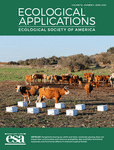
ECOLOGICAL APPLICATIONS
Pioneering research for the preservation of our planet.ECOLOGICAL APPLICATIONS, published by WILEY, is a leading journal in the field of ecology, providing a platform for innovative research that addresses the understanding and management of ecological systems. With an ISSN of 1051-0761 and E-ISSN of 1939-5582, it has established itself as a vital resource for ecologists and environmental scientists since its inception in 1991. Ranked in the top quartile (Q1) for Ecology in 2023 and with a Scopus ranking of 40 out of 461 in Environmental Science, ECOLOGICAL APPLICATIONS boasts an impressive impact factor, attesting to its significance and influence in the field. The journal's mission is to publish peer-reviewed articles that contribute to ecological theory and its applications in conservation and environmental management. Researchers, professionals, and students alike will find invaluable insights and the latest developments in ecological research through its comprehensive scope and rigorous scholarship, ensuring a crucial role in shaping future ecological practices and policies.
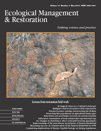
ECOLOGICAL MANAGEMENT & RESTORATION
Connecting science and practice in ecological management.Ecological Management & Restoration is a premier international journal published by Wiley, dedicated to advancing the fields of ecology, environmental management, conservation, and restoration practices. With an impact factor that positions it in the Q2 category across various ecological and management domains, this journal serves as a critical platform for researchers and professionals seeking to address contemporary issues related to ecosystem health, biodiversity, and sustainable management. Covering a wide range of topics from ecological restoration techniques to policy impacts on nature conservation, the journal caters to a diverse audience and contributes to the scientific community's understanding of environmental challenges. Importantly, the journal provides significant visibility, ranking in the top percentiles within key ecological research arenas such as Nature and Landscape Conservation, reinforcing its value for researchers aiming to influence both scientific thought and practical applications in ecology and management. The journal's commitment to disseminating high-quality research makes it an essential resource for students, researchers, and practitioners dedicated to fostering a sustainable future.

Ecosistemas
Advancing ecological understanding for a sustainable future.Ecosistemas is a prominent Open Access journal published by the ASOCIACION ESPANOLA ECOLOGIA TERRESTRE, specializing in the field of ecology. Since its inception in 2001, it has dedicated itself to advancing ecological knowledge and research, fostering an inclusive platform for the dissemination of cutting-edge studies that span ecological interactions, sustainability, and biodiversity. The journal, based in Spain, has established its reputation with notable rankings such as Q3 in the field of Ecology and Q4 in Ecology, Evolution, Behavior, and Systematics, reflecting its commitment to quality research. With a Scopus Ranks position placing it in the 40th and 37th percentiles for its categories, Ecosistemas is integral to the academic community, serving researchers, professionals, and students alike. It provides a vital resource for those seeking to understand ecological dynamics and environmental challenges, facilitating open access to important findings and discussions that shape the future of our ecosystems.
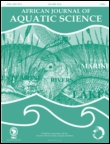
AFRICAN JOURNAL OF AQUATIC SCIENCE
Navigating the complexities of aquatic ecosystems together.AFRICAN JOURNAL OF AQUATIC SCIENCE, published by TAYLOR & FRANCIS LTD, is a premier scholarly journal dedicated to the field of aquatic science, ecology, and environmental management, playing a crucial role in advancing research and knowledge in these vital areas. With an impressive Q2 ranking in both Aquatic Science and Ecology, Evolution, Behavior and Systematics, the journal seeks to publish high-quality research encompassing a wide range of topics related to freshwater and marine ecosystems, including biodiversity, conservation strategies, and the impacts of climate change. Featuring a rich history of publication from 2000 to 2024, the journal not only embraces rigorous peer review but also aims to foster collaboration and dialogue among researchers, practitioners, and students interested in aquatic environments. Readers will find that the journal’s commitment to impactful scientific communication is reflected in its notable rankings within the Scopus database, making it an essential resource for those engaged in aquatic research and management.

NEW ZEALAND JOURNAL OF ECOLOGY
Connecting Ecologists to Shape Sustainable FuturesNEW ZEALAND JOURNAL OF ECOLOGY, published by the New Zealand Ecological Society, stands as a premier platform for disseminating research in the field of ecology, with a notable impact factor reflected in its Q2 ranking in multiple ecology categories for 2023. Established in 1980 and actively publishing since 1982, this journal provides a vital resource for ecologists and environmental scientists, fostering the exchange of innovative ideas and methodologies. The journal covers a wide range of ecological topics, ensuring a comprehensive overview of the current trends and research developments in both ecological theory and practical applications specific to New Zealand and beyond. Researchers, professionals, and students will find in this journal an authoritative source to advance their understanding of ecological dynamics and contribute to the growing field of ecological science. The journal is accessible to the community without open access, providing critical insights that underpin the ecological landscape of New Zealand and inform sustainable practices worldwide.

Global Ecology and Conservation
Connecting researchers to inspire ecological stewardship.Global Ecology and Conservation, published by Elsevier, stands as a premier open-access journal dedicated to advancing the field of ecology and conservation science. Since its inception in 2014, the journal has facilitated the dissemination of high-quality research, fostering critical dialogue on ecosystem management, biodiversity preservation, and sustainability practices across the globe. With a remarkable ranking within the top quartiles (Q1) in various categories including Ecology, Evolution, Behavior and Systematics, and Nature and Landscape Conservation, it is positioned among the leading resources for researchers and professionals alike. The journal has garnered a notable impact, ranking #65 out of 721 in Ecology, and houses articles that are vital to understanding and addressing the pressing environmental challenges of our time. Available in an open-access format, researchers can freely access and share vital findings, promoting a collaborative approach to ecological research. Global Ecology and Conservation is not just a publication; it is a critical tool for innovation and advocacy in conservation, poised to inspire the next generation of environmental stewards.

Mires and Peat
Connecting Research and Conservation for PeatlandsMires and Peat is a premier open-access journal focusing on the intricate and vital ecosystems of mires and peatlands, published by the International Peatland Society and the International Mire Conservation Group. Established in Germany, this journal has been serving the scientific community since 2006 and offers a unique platform for researchers, conservationists, and students to explore topics pertinent to aquatic sciences, ecology, and soil science. With impressive rankings across several Scopus categories, including a Q2 designation in Ecology and Nature and Landscape Conservation, Mires and Peat is recognized for its vital contributions to environmental science. The journal aims to disseminate innovative research and foster discussions that enhance understanding and conservation of peatland ecosystems, which are crucial for global biodiversity and climate regulation. Accessible to a broad audience through its open-access model, Mires and Peat stands out as an essential resource for those dedicated to advancing knowledge in this critical field.